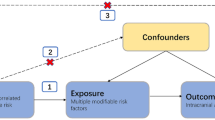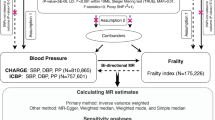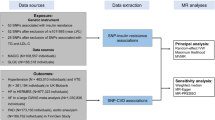Abstract
Hypertension or elevated blood pressure was documented to be an important risk factor for aortic diseases in observational studies, yet the causality remains to be determined. By applying a two-sample Mendelian randomization (MR) approach, we aim to determine whether hypertension or elevated blood pressure (systolic blood pressure [SBP] or diastolic blood pressure [DBP]) is linked causally to aortic aneurysm or aortic dissection. Genetic instruments and summary statistics for hypertension and aortic diseases were obtained from large genome-wide association studies. The traditional inverse variance weighted (IVW) method was used to obtain the causal estimates. Sensitivity analyses including MR-Egger, weighted median and multivariable MR were also performed. Our results suggested that genetic liability to hypertension was associated with aortic dissection (odds ratio [OR]: 1.81; 95% confidence interval [CI]: 1.27–2.58; P = 1.13 × 10−3) and aortic aneurysm (OR: 1.43; 95% CI: 1.22–1.66; P = 7.79 × 10−6). Per standard deviation increase in genetically-determined DBP was significantly associated with increased aortic dissection (OR: 1.14; 95% CI: 1.09–1.19; P = 1.58 × 10−9) and aortic aneurysm (OR: 1.07; 95% CI: 1.05–1.09; P = 8.37 × 10−14). There was a null association between SBP and aortic dissection (OR: 1.01; 95% CI: 0.99–1.94; P = 0.38) or aortic aneurysm (OR: 1.00; 95% CI: 0.99–1.01; P = 0.92). Sensitivity analyses documented similar results. Therefore, hypertension and elevated DBP are causally associated with higher risks of aortic aneurysm and aortic dissection. Preventive interventions for aortic diseases may consider individuals with hypertension, especially those with higher DBP. Meanwhile, further research is required to determine the mechanisms underlying the significantly greater correlation between DBP and aortic diseases than SBP.

This is a preview of subscription content, access via your institution
Access options
Subscribe to this journal
Receive 12 print issues and online access
$259.00 per year
only $21.58 per issue
Buy this article
- Purchase on Springer Link
- Instant access to full article PDF
Prices may be subject to local taxes which are calculated during checkout





Similar content being viewed by others
References
Avdic T, Franzén S, Zarrouk M, Acosta S, Nilsson P, Gottsäter A, et al. Reduced long-term risk of aortic aneurysm and aortic dissection among individuals with type 2 diabetes mellitus: a nationwide observational study. J Am Heart Assoc. 2018;7:1–10.
Landenhed M, Engström G, Gottsäter A, Caulfield MP, Hedblad B, Newton-Cheh C, et al. Risk profiles for aortic dissection and ruptured or surgically treated aneurysms: a prospective cohort study. J Am Heart Assoc. 2015;4:e001513.
Karthikesalingam A, Holt PJ, Vidal-Diez A, Ozdemir BA, Poloniecki JD, Hinchliffe RJ, et al. Mortality from ruptured abdominal aortic aneurysms: clinical lessons from a comparison of outcomes in England and the USA. Lancet. 2014;383:963–9.
Hagan PG, Nienaber CA, Isselbacher EM, Bruckman D, Karavite DJ, Russman PL, et al. The International Registry of Acute Aortic Dissection (IRAD): new insights into an old disease. JAMA. 2000;283:897–903.
Kobeissi E, Hibino M, Pan H, Aune D. Blood pressure, hypertension and the risk of abdominal aortic aneurysms: a systematic review and meta-analysis of cohort studies. Eur J Epidemiol. 2019;34:547–55.
Hu M-J, Tan J-S, Gao X-J, Yang J-G, Yang Y-J. Effect of cheese intake on cardiovascular diseases and cardiovascular biomarkers. Nutrients. 2022;14:2936.
Yuan S, Larsson SC. An atlas on risk factors for type 2 diabetes: a wide-angled Mendelian randomisation study. Diabetologia. 2020;63:2359–71.
Sudlow C, Gallacher J, Allen N, Beral V, Burton P, Danesh J, et al. UK biobank: an open access resource for identifying the causes of a wide range of complex diseases of middle and old age. PLoS Med. 2015;12:e1001779.
Bowden J, Davey Smith G, Burgess S. Mendelian randomization with invalid instruments: effect estimation and bias detection through Egger regression. Int J Epidemiol. 2015;44:512–25.
Burgess S, Bowden J, Fall T, Ingelsson E, Thompson SG. Sensitivity analyses for robust causal inference from Mendelian randomization analyses with multiple genetic variants. Epidemiology. 2017;28:30–42.
Sakalihasan N, Limet R, Defawe OD. Abdominal aortic aneurysm. Lancet. 2005;365:1577–89.
Tsai TT, Nienaber CA, Eagle KA. Acute aortic syndromes. Circulation. 2005;112:3802–13.
Kuang SQ, Medina-Martinez O, Guo DC, Gong L, Regalado ES, Reynolds CL, et al. FOXE3 mutations predispose to thoracic aortic aneurysms and dissections. J Clin Investig. 2016;126:948–61.
Boyle JJ, Weissberg PL, Bennett MR. Tumor necrosis factor-alpha promotes macrophage-induced vascular smooth muscle cell apoptosis by direct and autocrine mechanisms. Arterioscler Thromb Vasc Biol. 2003;23:1553–8.
Suzuki Y, Kaneko H, Yano Y, Okada A, Itoh H, Ueno K, et al. Dose-dependent relationship of blood pressure and glycemic status with risk of aortic dissection and aneurysm. Eur J Prev Cardiol. 2022. https://doi.org/10.1093/eurjpc/zwac205.
Hibino M, Otaki Y, Kobeissi E, Pan H, Hibino H, Taddese H, et al. Blood Pressure, Hypertension, and the Risk of Aortic Dissection Incidence and Mortality: Results From the J-SCH Study, the UK Biobank Study, and a Meta-Analysis of Cohort Studies. Circulation. 2022;145:633–44.
Nienaber CA, Clough RE, Sakalihasan N, Suzuki T, Gibbs R, Mussa F, et al. Aortic dissection. Nat Rev Dis Prim. 2016;2:16053.
Yin H, Pickering JG. Cellular senescence and vascular disease: novel routes to better understanding and therapy. Can J Cardiol. 2016;32:612–23.
Ju X, Ijaz T, Sun H, Ray S, Lejeune W, Lee C, et al. Interleukin-6-signal transducer and activator of transcription-3 signaling mediates aortic dissections induced by angiotensin II via the T-helper lymphocyte 17-interleukin 17 axis in C57BL/6 mice. Arterioscler Thromb Vasc Biol. 2013;33:1612–21.
Anzai A, Shimoda M, Endo J, Kohno T, Katsumata Y, Matsuhashi T, et al. Adventitial CXCL1/G-CSF expression in response to acute aortic dissection triggers local neutrophil recruitment and activation leading to aortic rupture. Circ Res. 2015;116:612–23.
Pichamuthu JE, Phillippi JA, Cleary DA, Chew DW, Hempel J, Vorp DA, et al. Differential tensile strength and collagen composition in ascending aortic aneurysms by aortic valve phenotype. Ann Thorac Surg. 2013;96:2147–54.
Jana S, Hu M, Shen M, Kassiri Z. Extracellular matrix, regional heterogeneity of the aorta, and aortic aneurysm. Exp Mol Med. 2019;51:1–15.
Strachan DP. Predictors of death from aortic aneurysm among middle-aged men: the Whitehall study. Br J Surg. 1991;78:401–4.
Franklin SS. Arterial stiffness and diastolic blood pressure: what is the connection? Artery Res. 2006;1:S1–6.
NCD Risk Factor Collaboration (NCD-RisC). Worldwide trends in blood pressure from 1975 to 2015: a pooled analysis of 1479 population-based measurement studies with 19·1 million participants. Lancet. 2017;389:37–55.
Asia WHOS-E. Hypertension. 2018. http://www.searowhoint/topics/hypertension/en/.
Lonn EM, Bosch J, López-Jaramillo P, Zhu J, Liu L, Pais P, et al. Blood-pressure lowering in intermediate-risk persons without cardiovascular disease. N Engl J Med. 2016;374:2009–20.
Acknowledgements
This work was supported by National Natural Science Foundation of China (81971588), Beijing Natural Science Foundation (7204289), and the Construction Research Project of the Key Laboratory (Cultivation) of Chinese Academy of Medical Sciences (2019PT310025).
Author information
Authors and Affiliations
Corresponding authors
Ethics declarations
Conflict of interest
The authors declare no competing interests.
Additional information
Publisher’s note Springer Nature remains neutral with regard to jurisdictional claims in published maps and institutional affiliations.
Supplementary information
Rights and permissions
Springer Nature or its licensor (e.g. a society or other partner) holds exclusive rights to this article under a publishing agreement with the author(s) or other rightsholder(s); author self-archiving of the accepted manuscript version of this article is solely governed by the terms of such publishing agreement and applicable law.
About this article
Cite this article
Yang, T., Yuan, X., Gao, W. et al. Causal effect of hypertension and blood pressure on aortic diseases: evidence from Mendelian randomization. Hypertens Res 46, 2203–2212 (2023). https://doi.org/10.1038/s41440-023-01351-6
Received:
Revised:
Accepted:
Published:
Issue Date:
DOI: https://doi.org/10.1038/s41440-023-01351-6



